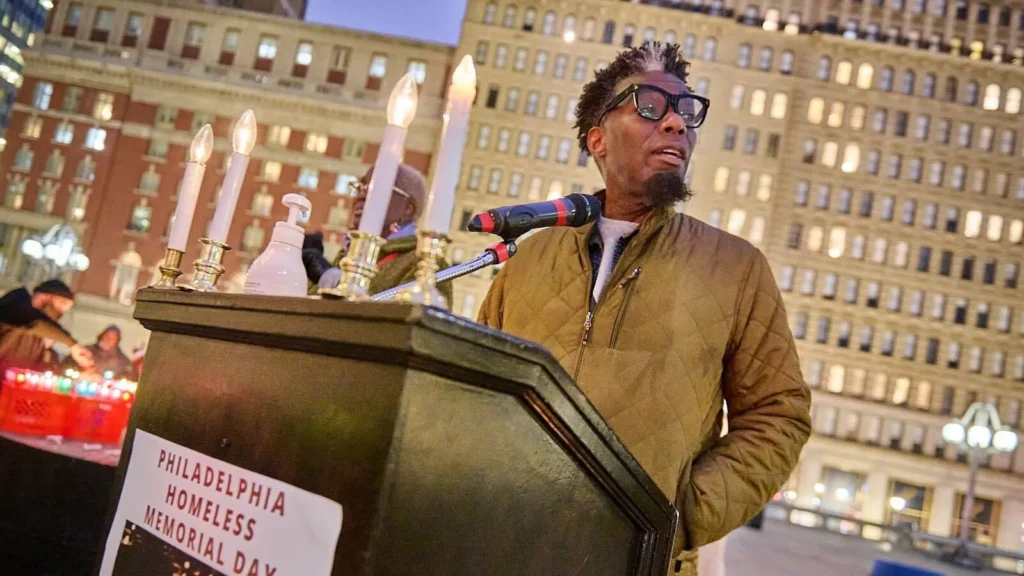Note: The following review contains Spoilers…
Its been over 30 years since the New York Native became the first newspaper to run a story about the “gay cancer” or what would become known as AIDS. Early queer cinema such as “Early Frost” and “Parting Glances” and later “Longtime Companion” (the first feature film on the subject to enjoy a wide release) were the first to address AIDS on screen. These films focused on gay characters with AIDS and their experiences dealing with the disease. But it was the 1993 feature film “Philadelphia” that truly changed the landscape of how films dealt with AIDS and brought AIDS awareness onto the Hollywood cause list and to greater national and international awareness. The film starred Tom Hanks as a gay man with AIDS and co-starred Denzel Washington as his lawyer, a character who begins with prejudice but ends with acceptance of gays and those with AIDS. Tom Hanks won the Oscar for Best Actor for his performance with the film taking home 2 more Oscars (Best Screenplay and Best Music).
In the 20 years since “Philadelphia” was released, many things have changed. HIV/AIDS is no longer a death sentence. So it might make sense to ask the question: why did we need a film about AIDS from the perspective of a straight, cisgeder, white male from Texas in the form of the “Dallas Buyers Club?” What if anything could this contribute to the public conversation and understanding about HIV/AIDS that hasn’t already been identified? And should we as members of the LGBT community pay attention?
“Dallas Buyers Club” like “Philadelphia” features a likeable Hollywood A List Star whose character gets AIDS. In each, we follow the men through their journey of life before and after the diagnosis. The behavior that results in becoming HIV positive. Then the prejudice and unfair treatment at the hands of friends, family, and the medical community. But that’s where the similarities end between the two films. “Philadelphia” was groundbreaking because its star, Tom Hanks was better known for light fluffy comedies and played gay at time when most stars felt this would ruin their careers. He became the “acceptable” face of the AIDS experience to audiences all across America who had no other access to LGBT history or LGBT stories—those of us too young to have known anyone who died during the 80s epidemic and the many Americans who had never knowingly seen a “gay” face before in their lives. This was a time when virtually no LGBT history courses were being taught in American colleges and gay Americans outside the most liberal cities stayed in the closet or lived in the shadows.
Where “Philadelphia” gave us likeable, largely sanitized gay lovers dealing with AIDS as played by Tom Hanks and Antonio Banderas, “Dallas Buyers Club” revels in offering us something raw and gritty when compared to its filmic predecessor. Matthew McCaughney plays Ron Woodruff, a Texas good ole boy who appears to spend more time partying, fornicating, and gambling on the rodeo than working his job as an electrician in the Texas oil fields. He’s so unlikeable that only McCaughney’s irrepressible charm oozing through the role makes watching or caring seem possible. And while this film may not be ground breaking in the same way that “Philadelphia” was, it gives a face to another, rarely discussed part of the AIDS story, what it was like to be a straight man with AIDS during the 1980s. Woodruff begins the film full of the stereotypical homophobia expected from a straight white man born in 1980s America but through his experiences becomes not just accepting of, but embraced by the LGBT community. He’s also from the southwest, an area of the country so often ignored by Hollywood. Westerns aside.
McCaughney picked up a Golden Globe and a SAG Award plus an Oscar nod giving his best performance to date in this film. But its not just McCaughney we’re here to see. Jared Leto plays Rayon a Male to Female transgender person who resorts to prostitution and drugs to deal with the demons resulting from being rejected by her birth family and homelessness, a story that is sadly just as relevant now as it was during the time the film is set. Leto’s performance is a scene stealer throughout the film and rightfully garnered him a Golden Globe, SAG Award and an Oscar nomination same as McCaughney. While I’m frustrated as a film goer that mainstream roles for trans identified characters seem largely stuck in this stereotype, I would recommend seeing this film purely for Leto’s performance alone.
Jennifer Garner makes an appearance as a sympathetic doctor who treats both Woodruff and Rayon. While its nice to see Garner attempt a more serious role, she is the one actor in this film who consistently struck me as out of place in the time period. She constantly looks like she belongs in the 1990s not the 1980s and never seems to fully connect with her costars.
But “Dallas Buyers Club” is more than just a film about personal experiences in the face of prejudice and ignorance in the 1980s. And that’s what makes this film unique.
“Dallas Buyers Club” comes at a time when many in the LGBT community and straight community alike take for granted that modern medicine through pharmaceutical research has come up with a drug cocktail that has made some members of our community complacent, even cavalier, about the dangers of becoming HIV positive. I still shudder every time I hear a friend say that it’s no longer a big deal if they get HIV as if it’s an inconvenience rather than a game changer. Sadly for those I know who have contracted HIV, its a different story. While no longer an imminent death sentence, it is a life changing diagnosis that can have huge health consequences not to mention the affects on the body from a daily multi-pill pharmaceutical regimen. Just the costs of more than $1,500/month for the medication without insurance is sobering. And while things may be better, there is still very much a stigma attached to the diagnosis that impacts relationships, jobs, housing, insurance etc. that cannot be ignored no matter how far we’ve come.
For that reason alone “Dallas Buyers Club” is a timely reminder to an entire generation of Americans that HIV/AIDS is a devastating disease worthy of our respect, highlighting the need for continued safer sex education, greater access to testing, and ongoing education to support conversations about disclosing HIV status.
But more than this “Dallas Buyers Club” goes on to highlight the very real problems that those infected with HIV and suffering from AIDS faced in terms of getting access to treatment and medicines during the height of the crisis.
The 1980s was a time when Gay Straight Alliances didn’t exist. ACT UP and other LGBT rights organizations were fiercely fighting simply to make AIDS visible and demand that American drug companies and the medical establishment offer any treatment beyond palliative treatment before a swift and debilitating death for those who became infected, gay and straight alike. The story takes an unexpected turn when Ron Woodruff is refused entrance into the clinical trials for AZT and is therefore refused access to the only FDA approved medication that might counter the affects of AIDS. In so doing Woodruff confronts his homophobia and must take his treatment into his own hands.
This is where we come to understand how the film got its name. When Ron Woodruff is rejected from the AZT trials, he starts the Dallas Buyers Club. Buyers Clubs existed in major cities all over the country for those who, like Ron could not get or afford the medicines to treat HIV/AIDS any other way. They were also a way to bring drugs that were proving to be successful around the globe in treating HIV/AIDS before legislative change or FDA approval made them available. To get around FDA regulations, those with HIV/AIDS would become members of their regional “buyers club” and receive their medications for “free” so long as they paid their monthly membership dues. And as in Woodruff’s case these medicines had to be smuggled into the country. We also see from Woodruff’s perspective what it was like to be one of the many men and women who filed suit then clung to life waiting for their cases to be heard before the Supreme Court. Sadly, many died before American HIV/AIDS health policy changed.
Canadian Director, Jean-Marc Valeé, clearly has little regard for the American pharmaceutical industry or the FDA at this time. And perhaps what this film does is to provide a vessel for his, and through this lens, an entire generation’s rage. LGBT elders recount a time when their friends were fresh faced and twenty three one moment and dying in the most horrible ways imaginable the next week. And yet this is another place where the film connects with attitudes today as so many have begun to question the blind faith we’ve been asked to put into the pills that are even much more commonly prescribed to “cure” what ails us only to find out later that there are drastic, even potentially fatal consequences that have often gone unexposed until a recall triggered by a class action lawsuit occurs. Unfortunately, this part of the film struck me as heavy handed.
In watching this film, I felt the AIDS era slogan Silence=Death take on new meaning. Ongoing prejudice and societal ignorance stifled successive generations of our community and our ability to give voice to the rage that resulted from the AIDS crisis. Decades of denial, grief, and prejudice coupled with ongoing prejudice deepened an existing crisis in the form of higher rates of drug use, dependency, alcoholism, and mental health issues within the LGBT community that still exist today. While members of the LGB community may now openly serve in the military or marry in 18 states plus Washington D.C., the FDA still bans blood donations for life from anyone who identifies as male and gay or bisexual despite the presence of available testing that could ensure that America’s blood supply remains free from HIV/AIDS. Transgender men and women still cannot open serve in the military. Men and women who marry their same sex partner can leave the state where their marriage occurred and have those rights stripped or unevenly applied, still resulting in the denial of shared parental rights, end of life decisions, inheritance, etc. LGBT Americans can still be fired from most workplaces simply for being LGBT. We still struggle as a community to find constructive ways to express our collective rage in the face of these injustices and members of our community must still attempt to hold their lives together while they wait for their cases to work there way towards uncertain justice before the US Supreme Court.
But what I keep coming back to and where I feel the film succeeds the most is in the relationship between, Ron Woodruff and Rayon. What’s interesting to me is the parallel the film draws between these two characters. Both Woodruff and Rayon have a history of abandonment and rejection by their birth families. This leads each down their own path of self-loathing and insecurity, compensated for by drug use and promiscuity. It’s made clear in Woodruff’s case that this is how he became infected. In Rayon’s case its implied. And in both cases, it leads to their eventual deaths. This is where the film does its more transformative work on the personal level. And it’s a reminder of how much work we still need to do as a community to heal and move forward.
If anything “Dallas Buyers Club” is a reminder that the AIDS crisis is not as far behind us as we thought.






